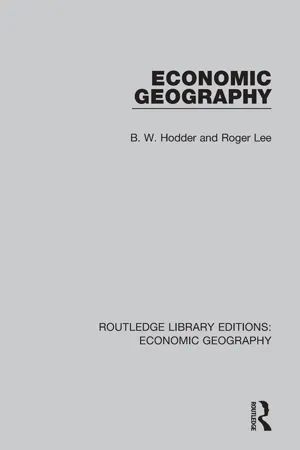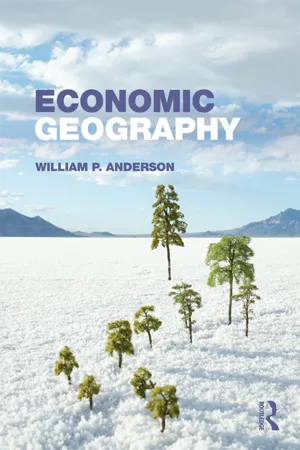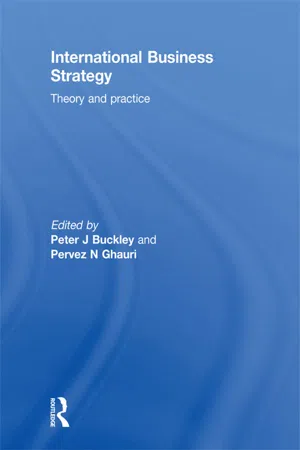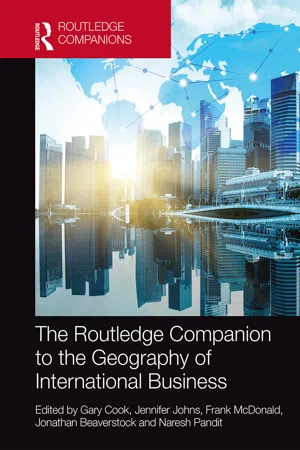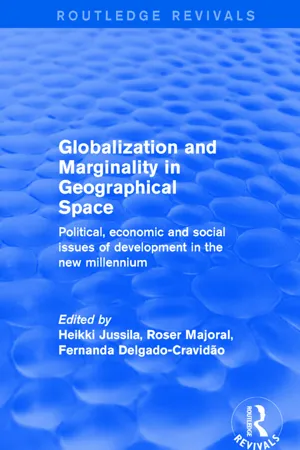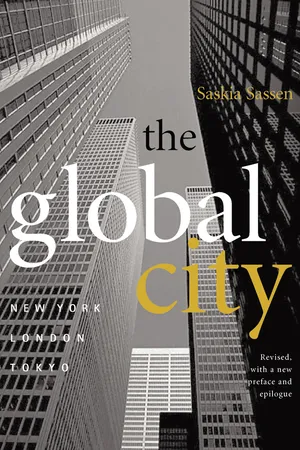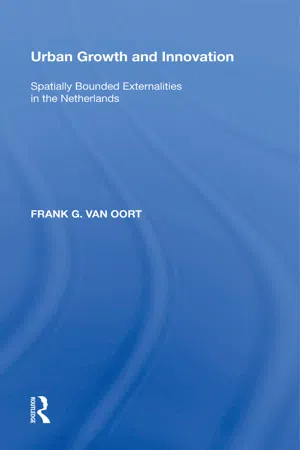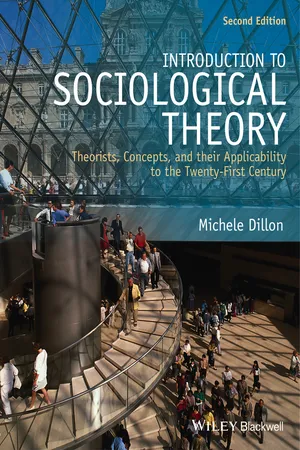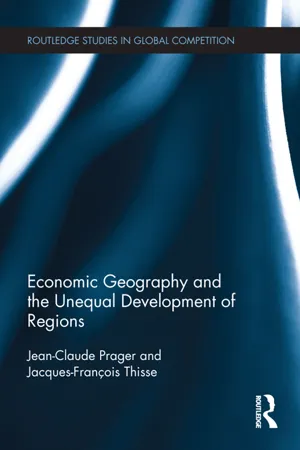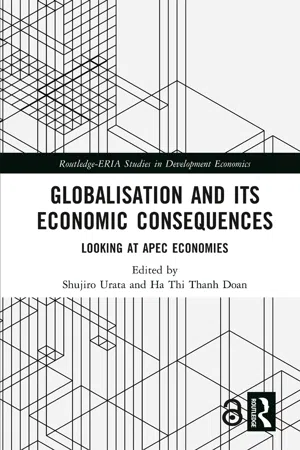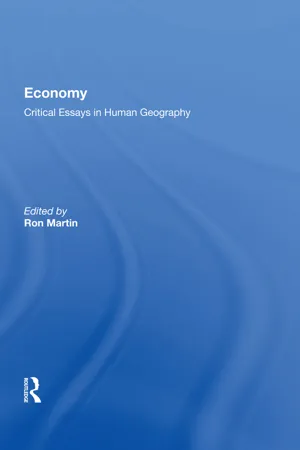Geography
Economic Impact of Globalisation
The economic impact of globalization refers to the effects of increased interconnectedness and interdependence of economies on a global scale. This includes the flow of goods, services, capital, and technology across borders, leading to both opportunities and challenges for different regions and industries. It can influence employment patterns, income distribution, and the overall economic development of countries.
Written by Perlego with AI-assistance
Related key terms
12 Key excerpts on "Economic Impact of Globalisation"
- eBook - ePub
- B. W. Hodder, Roger Lee(Authors)
- 2015(Publication Date)
- Routledge(Publisher)
Finally, the concept of the economy underlies the logic of the discussion in the sections that follow. The next chapter presents a selective review of literature in the field of economic geography against the background of the concept of the economy developed so far. Then follows the second and longer section of the book in which there is a discussion of the mechanisms of decision making and control. This involves a study of demand, supply, price and the market mechanisms; the alternative or complementary role of government control; and the decision-making activities of consumers, firms and resource owners. The third section of the book takes a closer look at the physical expression of integration within and between economies in the form of flows of goods, people and ideas, and the spatial structure of market centres and transport networks. The final section is devoted to a brief review of the geography of economic growth and development. This is a rapidly growing field of applied economic geography and demonstrates the apparent inability or unwillingness of the world economy to redistribute economic power or wealth from the rich to the poor. Intolerable economic inequalities, whether structural or spatial, and the associated ecological implications of the great but highly concentrated productive power of the world economy are perhaps the two major problems facing mankind.Passage contains an image
2 Geographical studies of economic activityThe concept of the economy has rarely been used explicitly in geographical studies of economic activity; economic geography, in general, has been concerned with matters other than the operation of economies, the behaviour and interaction of their elements or the implications of the prevailing distribution of economic power. Within the existing literature in economic geography it is possible to distinguish two overlapping approaches to the study of economic activity. Systematic approaches are normally defined in terms of specific products (e.g. wheat), sectors (e.g. energy) or processes (e.g. trade), and are concerned with the spatial structure of these phenomena. Spatial approaches are defined in terms of specific two-dimensional, abstract, national or regional space and are concerned with the spatial structure of economic activity within these areas and with the effects of economic activity upon their economic and regional character.Systematic approaches
An early emphasis in economic geography was upon the scientific study of world areas in their direct influence upon the production of goods (Götz 1882). This approach sought to lay bare the influence of the natural environment upon the occupations, products and lives of people in different regions of the world (Wooldridge and East 1966). The best-known example of this approach is Chisholm’s handbook of commercial geography - eBook - ePub
- William P. Anderson(Author)
- 2012(Publication Date)
- Routledge(Publisher)
Part VI Globalization and the knowledge economyPassage contains an image
24 International trade and foreign direct investment
DOI: 10.4324/9780203114988-30This is the first of three chapters on globalization and the knowledge economy. These two topics address profound changes in the spatial patterns of production, distribution and consumption that are rapidly altering the economic landscape. While neither topic is really new – both refer to processes that have been under way for centuries – political, institutional and technological changes in the second half of the twentieth century have led to ever faster and more obvious economic transformation.A number of books have been written that seek to explain how the global knowledge economy of the twenty-first century came to be, how it works, who benefits, who suffers and what implications it has for global politics.1 Our objective here is more modest. Essentially, the next three chapters address the following question: how does the transition to a global knowledge economy affect the principles of economic geography as set forth in the first five sections of this book? Some observers argue that globalization and the proliferation of information and communications technology means that space is becoming irrelevant, distance is disappearing, so economic geography as we know it is out the window. But the fact that distance is getting easier to overcome does not mean it no longer matters. As we have already seen, reductions in the friction of distance lead to predictable changes such as increased scale of production and more spatial interaction. Perhaps most importantly, cheaper transportation and better communication make it easier for firms to exploit spatial differentiation at a global scale.These issues will be addressed in detail later, but at the outset some basic definitions are needed. The term “globalization” seems to have as many definitions as there are books and articles written about it. For the moment, let’s settle for a very simple definition of globalization as the integration of economic activity at a global scale. Of course, this begs the question: what do we mean by integration? International trade and foreign direct investment are both forms of economic integration that can be measured in terms of flows of goods or funds between nations. In these cases, production is still conducted within national borders. At a deeper level of integration, the production process itself involves tasks performed by different actors at different locations around the globe who are closely coordinated via information and communications networks. As we will see, people from a dozen or more countries may have been involved in the design, production, distribution and marketing of the shirt you are wearing right now. It is this more complex type of integration that most people have in mind when they speak of globalization. To make this distinction clear, we will use the term internationalization - eBook - ePub
International Business Strategy
Theory and Practice
- Peter J Buckley, Pervez Ghauri, Peter J Buckley, Pervez Ghauri(Authors)
- 2015(Publication Date)
- Routledge(Publisher)
The intention of this paper is to review the literature linking ownership and location strategies to economic geography and theories of globalisation and to explore new areas of research. The paper focuses on the relationship between the evolving strategies of MNEs, the changing economic geography of the world economy and globalisation. The first section charts the conflicts between markets and government policies as markets integrate across national borders. Markets are globalised by the actions of MNEs. This is a deliberate process, but it is proceeding at a differential pace in different types of market. The drivers of this process – the location and ownership strategies of MNEs – are examined in the second section. These strategies revolve around the ability of MNEs to subdivide their activities more precisely and to place them in the optimal location. At the same time, more sophisticated and wider control strategies ranging from full ownership to market relationships are used to coordinate global activities. This, it is argued in the third section, makes economic geography more important than ever. Where an activity is placed it interacts with its immediate hinterland and this has profound consequences for changing economic power and development. Finally, the article examines protests against globalisation that leads to the concluding research agenda.Conflict of markets with national policies in the global economy
As Sideri (1997, 38) says, ‘globalisation is essentially a process driven by economic forces. Its immediate causes are the spatial reorganisation of production, international trade and the integration of financial markets’. It is not uniform across economic space; ‘the segmentation of the manufacturing process into multiple partial operations, combined with the development of cheap transportation and communication networks, has brought the increasing division of production into separate stages carried out in different locations’. The strategies of multinational firms are crucial to the causes and consequences of globalisation.We can examine globalisation as a conflict between markets and management (policies). Figure 8.1 identifies three levels of markets: financial markets, markets in goods and services and labour markets. Each of these is moving at a different speed towards global integration. Financial markets are already very closely integrated internationally, so that no individual ‘national capital markets’ can have a sustainable independent existence. However, attempts at national regulation do persist (Laulajainen, 2000 ) and the role of localities in the financial markets still provides differentiation (Berg and Guisinger, 2001 ; Tickell, 2000 ). Despite this, it is legitimate for analytical purposes to hypothesise a single integrated global capital market. Regional economic integration (REI) is becoming increasingly effective in integrating goods and services markets at the regional level. The relationship between company strategy and policy-making within regional blocs such as the EU is a fascinating area for the development of new research streams (Chapman, 1999 ; Raines and Wishlade, 1999 ; see also, Wood, 2003 on the Industrial Midwest of America). Labour markets, however, are functionally separate at the national level and here integration is largely resisted by national governments (Buckley et al. - Gary Cook, Jennifer Johns, Frank McDonald, Jonathan Beaverstock, Naresh Pandit, Gary Cook, Jennifer Johns, Frank McDonald, Jonathan Beaverstock, Naresh Pandit, Gary Cook, Jennifer Johns, Frank McDonald, Jonathan Beaverstock, Naresh Pandit(Authors)
- 2018(Publication Date)
- Routledge(Publisher)
My arguments for closer intellectual interaction between Economic Geography and International Business studies points to the usefulness of making global connections through transdisciplinarity and the analytical relevance of understanding flows and relations across space. This geographical approach goes beyond agency-centric views common in International Business studies and moves towards a GPN of International Business studies through the engagement, connectivity and transformation of knowledge in the Economic Geography of International Business activities. p.186 The implications of this approach for the analysis of the geography of International Business are manifold and complex. There are at least two explicit implications that should be laid out briefly here. First, instead of asking whether TNCs have a global strategy to compete for the future, International Business researchers can ask whether these global lead firms have a spatial strategy. Mundane as it might sound, this question can be fundamentally important to corporate performance and success because today’s economic competition is not necessarily pitched at the global scale only. As discussed extensively in this chapter, corporate competition indeed operates at all spatial scales, and corporate success can only be secured through an understanding of these overlapping scales of competitive fields. By privileging the global scale, the competitive strategy literature in International Business studies might have misled us by placing too much emphasis on the centralization and implementation of corporate decisions on a global scale- eBook - ePub
Globalization and Marginality in Geographical Space
Political, Economic and Social Issues of Development at the Dawn of New Millennium
- Heikki Jussila, Roser Majoral, Fernanda Delgado-Cravidao(Authors)
- 2017(Publication Date)
- Routledge(Publisher)
Review, vol. 15, no. 4, pp. 651–670.Wheeler, James O., Muller, Peter O., Thrall, Grant Ian and Fik, Timothy J. (1998), Economic Geography, Third Edition, John Wiley & Sons, Inc., New York.Wong, K. and Chu, D.K.Y. (1984), ‘Export Processing Zones and Special Economic Zones as Generators of Economic Development: The Asian Experience’, Geografiska Annaler, vol. 66, pp. 1–16.Passage contains an image
J. CLARK ARCHER AND RICHARD E. LONSDALE4 Great Plains settlement: Globalization and deregulation
Introduction
Globalization of the world economy has been gaining momentum for many years, but widespread recognition of its scale and manifestations has occurred only more recently. It involves the spatial reorganization of production and trade, the interpenetration of industries across national borders, the broad extension of financial markets and the diffusion of similar consumer goods world-wide (Mittelman, 1997). Another related phenomenon also gaining momentum has been deregulation, with many governments reducing their role in guiding and controlling the business sectors of their economies.Although spatial diffusion theory might seem to imply that marginal lands should be less susceptible to the effects of these processes because of their often-peripheral locations away from centres of innovation, the converse may be closer to the truth. Marginal environmental circumstances combined with geographic isolation are apt to restrict the range of alternative resource uses and to increase the level of economic specialization (Hite, 1997). In marginal lands the economic focus is mainly on primary activities, which in turn usually link to a fragile demographic structure indicated by a declining population and the slow death of small towns (Sanchez Aguilera, 1996; Lonsdale and Archer, 1998). - eBook - ePub
The Global City
New York, London, Tokyo
- Saskia Sassen(Author)
- 2013(Publication Date)
- Princeton University Press(Publisher)
Part One THE GEOGRAPHY AND COMPOSITION OF GLOBALIZATIONA LEADING ARGUMENT in this book is that the spatial dispersion of economic activities and the reorganization of the financial industry are two processes that have contributed to new forms of centralization insofar as they have occurred under conditions of continued concentration in ownership or control. The spatial dispersion of economic activity has brought about an expansion in central functions and in the growing stratum of specialized firms servicing such functions. Reorganization in the financial industry has been characterized by sharp growth, rapid production of innovations, and a proliferation of financial firms. These conditions, I argue, shifted the point of gravity in the industry away from the large, mostly American, transnational banks that had once dominated the industry toward major centers of finance.The fact that telecommunications and information technologies are essential to both processes has added yet another force for agglomeration. Finance and specialized services are major users of such technologies and need access to the most advanced facilities. These technologies, which make possible long distance management and servicing and instantaneous money transfers, require complex physical facilities, which are highly immobile. Such facilities demand major investments in fixed capital and continuous incorporation of innovations. A second and, I will argue, crucial factor giving global cities an advantage is the organizational complexity they contain which allows firms to maximize the benefits they can derive from the new technologies.International transactions have expanded the scale and raised the complexity of these processes. However, the spatial and organizational logic at work is also evident at the national level. Whether internationalization is essential to the major outcomes, notably the acute pressure, toward agglomeration in leading cities, is difficult to establish and is perhaps a question of theory. But the requirements that global production arrangements and markets bring about are a key factor in the organization of major industries and in the significance of specialized services for firms. - eBook - ePub
- Dov M. Gabbay, Paul Thagard, John Woods(Authors)
- 2012(Publication Date)
- North Holland(Publisher)
The relationship between economics and geography had traditionally been one of boundary maintaining. Things have changed however with the appearance of GeoEcon. Geographers have perceived GeoEcon as an attempt to invade their own territory. For instance, economic geographers Ron Martin and Peter Sunley [2001, p. 157] confidently claim that “Fine (1999) talks of an economic imperialism colonizing the social sciences more generally, and this is certainly the case as far as the ‘new economic geography’ is concerned.” 11 GeoEcon, it is said, has broken the disciplinary boundaries, and has done so unilaterally. Economics is notorious for its repeated attempts at colonizing the domain of neighboring disciplines. Economics-style models and principles are used to study marital choices, drug addiction, voting behavior, crime, and war, affecting disciplines such as sociology, anthropology, law and political science. The phenomenon of economics imperialism has received a great deal of attention among social scientists: while some celebrate it unconditionally, others despise it. Few philosophers of economics however have entered the debate. This is unfortunate because philosophers have something to contribute in evaluating the benefits and risks of episodes where disciplinary boundaries are broken. This is what the analysis that follows aims to accomplish. If GeoEcon constitutes an instance of economics imperialism, we should ask whether it is to be blamed or celebrated. In other words, the key issue is whether this episode of boundary breaking is beneficial or detrimental to scientific progress. In a series of recent papers Uskali Mäki [ 2001 ; 2009, and Mäki and Marchionni, 2011 ] has sought to provide a general framework for appraising economics imperialism. The point of departure of Mäki’s framework is to see scientific imperialism as a matter of expanding the explanatory scope of a scientific theory. This aspect of scientific imperialism he calls imperialism of scope - eBook - ePub
Urban Growth and Innovation
Spatially Bounded Externalities in the Netherlands
- Frank G. van Oort(Author)
- 2017(Publication Date)
- Routledge(Publisher)
Chapter 2 Agglomeration in Economic and Geographical Theories 2.1 Introduction The Resurgence of Agglomeration Economies as a Fuzzy Concept? 1 The wealth of nations is not evenly spread among its regions and within regions among locations. It would be better to speak of wealth of regions and locations instead (Porter 1998). But what exactly fosters the competitive advantage of nations, regions, cities and locations? Much of the current debate in the economic and geographical literature is focused on the determination of explaining static and dynamic circumstances for this stylized fact 2. Especially since the early 1980s the spatial configuration of the economy became of interest in mainstream western social science, including political scientists, sociologists, economists and geographers. For some, this interest was considered renewed because long traditions already exist on spatial (aspects of) analysis in their respective disciplines (Storper 1997). A central theme in this 'resurgence' of geographical thought concerns the revived value attached to the concept of agglomeration economies. This is the element most perceived as stylized fact, because clustering of population and economic activity in cities and regions is among the most common observations in every society. Discussions though exist on the exact substance and (economic) mechanisms behind these agglomeration forces. The notion of economic agglomeration has only to limited degree been perceived as a crucial factor in geographical and economic theory. And the renewed recent attention on the spatial dimension of economic activity in the mainstream literatures does not unambiguously clarify important conceptual difficulties in the agglomeration discussions (yet). Especially spatial conceptualization remains scattered and therefore often fuzzy in character (Parr 2002) - eBook - ePub
Introduction to Sociological Theory
Theorists, Concepts, and their Applicability to the Twenty-First Century
- Michele Dillon(Author)
- 2013(Publication Date)
- Wiley-Blackwell(Publisher)
intra -national (within-country) inequality as a result of “the fact that the opening to trade and foreign investment was incomplete,” concentrated, for example, in select cities and provinces at the expense of rural and other areas (Lindert and Williamson 2003: 255). By extension, in this view, global inequality is a result of “differential access to the benefits of the new economy” and of particular countries’ and regions’ failures to participate in globalization (2003: 263).Sociologists apply a different framework to the economic aspects of globalization. They fully recognize the expansion of new markets that is entailed in globalization, emphasizing in particular, as Giddens notes (1990: 76), the many advances made post-World War II in expanding global relations of economic interdependence, and opening up new geographical centers of industrial production, including the emergence of newly industrializing countries in the third world (1990: 76). Subsequently, the rise of a post-industrial information and service economy (see chapter 6), and what today can be called a transnational informational economy (e.g., Fuchs 2008) further expanded world markets and the transnational social and political relationships that this expansion necessitates. But, in highlighting these globalizing forces, sociologists also highlight the historical, geographical, and structural unevenness of globalizing economic processes (Wallerstein 2004), and their weakening effects on local subsistence economies (e.g., Giddens 2003: 17).IMMANUEL WALLERSTEIN: THE MODERN WORLD-SYSTEM
Any sociological discussion of economic globalization must necessarily engage the theorizing of the American sociologist Immanuel Wallerstein. He argues that the association of globalization with relatively open economic frontiers between countries is part of a much longer “cyclical occurrence throughout the history of the modern world-system,” a world-system in which economic logic is the primary driver (Wallerstein 2004: 93). Wallerstein was influential in establishing the idea of a capitalist world-system . In his three-volume historical analysis of “the creation of the modern world” (Wallerstein 1974: 3), he detailed the formation of capitalism as a bounded, historically unique, and economically distinctive world-system that emerged in Europe in the sixteenth century.1 - Jean-Claude Prager, Jacques-François Thisse(Authors)
- 2012(Publication Date)
- Routledge(Publisher)
2 Economic geography
Facts and theories
The shaping of the space-economy
High population density fosters the division of labor
What are the main geographical forces that affect the economic and social development of a given region or country? The first was identified by Adam Smith more than two centuries ago: “the extent of the division of labor is limited by the size of the market.” The market is defined here as the range of customers that producers can supply through existing transport technologies. This suggests that the high population density prevailing in cities allows a degree of task specialization that is not found in rural areas, since such density ensures that there will be outlets to support local craftsmen and workshops. To a large extent, city dwellers produce neither the food they eat nor the energy they consume. In exchange for the farm products and energy they need, they must therefore supply goods and services that are not produced in rural areas. The production of such commodities requires greater task specialization than is typically found in the countryside.In addition, a city is its own primary outlet, since the inhabitants consume a high proportion of the goods and services produced there. In other words, the city itself is the main component of its market. This observation is relevant because most services are by nature non-transportable and must be consumed where they are produced. Since the export base often accounts for only a small share of a city’s activities, local services are a crucial factor in urban growth.To justify acquisition of the skills required for such task specialization, cities and their hinterlands must therefore be of a certain size. To put it simply, a sufficiently large and relatively concentrated population is needed. Once this condition has been met, a finer division of labor generates an urban surplus that can be shipped to the city’s rural hinterland and sometimes to other cities specializing in the production of different goods. The combination of these two forces generates surpluses of various natures and origins, which in turn are traded between the rural and urban populations. In most cases, this process has been slow because it is subject to many contingencies: these surpluses leave the subsistence economy and enter the trade economy, which requires much more complex institutions than those of the rural community, especially the use of money.- eBook - ePub
Globalisation and its Economic Consequences
Looking at APEC Economies
- Shujiro Urata, Ha Thi Thanh Doan, Shujiro Urata, Ha Thi Thanh Doan(Authors)
- 2021(Publication Date)
- Routledge(Publisher)
8 The economic consequences of globalisation in the United States Peter A. Petri and Meenal BangaDOI: 10.4324/9781003138501-81 The globalisation debate
In 1999, Merrill Lynch, a leading wealth manager in the US, took out full-page ads in major US newspapers to celebrate the era of globalisation: ‘The World Is 10 Years Old. It was born when the Wall fell in 1989.’ The ads argued that the ‘spread of free markets and democracy around the world is permitting more people everywhere to turn their aspirations into achievements. And technology, properly harnessed and liberally distributed, has the power to erase not just geographical borders but also human ones.’The current era of globalisation began in the 1970s, when the share of trade in world output was around 10% (Figure 8.1 ). Globalisation accelerated in the 1980s, when the share of world trade in output surpassed historical records, eventually climbing to about 25% by 2009. Since then, the trade share of GDP has flattened. For reasons ranging from trade policy to technological changes and the maturation of international supply chains, trade intensity is not likely to rise as fast in the future as it did in recent decades.Figure 8.1 Value of Exported Goods as a Share of Gross Domestic Product.Source: Fouquin and Hugot (2016) .Note: GDP = gross domestic product.The unprecedented rise in global interdependence has been very productive. World GDP growth, which hovered in the 2% per year range in the 1970s and early 1980s, doubled to reach the 4% range before the global financial crisis. Growth spread to the world’s largest countries and lifted more than a billion people out of extreme poverty. New global supply chains brought emerging, trade-oriented economies into the network of global expansion. However, the fragility of rapid, interdependent growth also became apparent. In 2008, Merrill Lynch succumbed to the global financial crisis. Meanwhile, criticism of the distributional effects of globalisation, particularly in advanced countries, intensified as Piketty (2015) - eBook - ePub
Economy
Critical Essays in Human Geography
- Ron Martin(Author)
- 2017(Publication Date)
- Routledge(Publisher)
Our conceptualization does not attempt to develop a comprehensive standard theory which is capable of explaining and predicting all possible outcomes of social and economic processes in space. Rather, the framework developed in this paper presents an interdisciplinary and multidimensional relational view which can be applied to a large number of research problems in economic geography, especially those that we have personally dealt with over the past decade. From a relational view, which rests on the assumptions of contextuality, path-dependence, and the contingency of economic action, a standard body of theory would be a virtual impossibility anyway. Instead, we aim to uncover a novel way to help formulate research questions in economic geography, different from those in traditional regional science (or spatial analysis), yielding subsequently different answers.In focusing on the geography of the firm, an alternative relational view of economic geography would pose the following types of questions: how do firms interact with one another and what are the consequences for localized processes and structures? In which way are firms influenced by institutional and socio-cultural contexts in their home base and how does this change when they expand to other contexts? How are firms, networks of firms and production systems organized and how does this organization vary from place to place and which territorial consequences result from this? Through which processes do new institutions evolve and how are the localized?24 Which interactive communication and adjustment processes with other firms and formal institutions allow firms to shape their environments and improve competitiveness? What are the impacts of global changes in technology, demand and competition on the organization of production and how do these effects vary between communities, regions, and nations?In our view, these questions are particularly relational for they systematically draw on the concepts of context, contingency and path-dependence of economic action and its localized consequences as a point of departure for analysis in economic geography. To answer these questions, we require a fundamental revision of traditional concepts in economic geography, such as that of the four ions which we have developed in the context of the geography of the firm. Our intention is to provide a starting point for analysis which can be further explored and applied in different contexts of economic geography.
Index pages curate the most relevant extracts from our library of academic textbooks. They’ve been created using an in-house natural language model (NLM), each adding context and meaning to key research topics.
